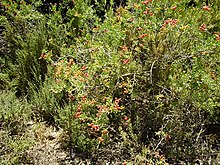Nitraria billardierei
| Nitre bush | |
|---|---|

| |
| Scientific classification | |
| Kingdom: | Plantae |
| Clade: | Tracheophytes |
| Clade: | Angiosperms |
| Clade: | Eudicots |
| Clade: | Rosids |
| Order: | Sapindales |
| Family: | Nitrariaceae |
| Genus: | Nitraria |
| Species: | N. billardierei
|
| Binomial name | |
| Nitraria billardierei | |
Nitraria billardierei, commonly known as nitre bush or dillon bush,[2] is a perennial shrub native to Australia. It is often found in saline areas or other areas which have been disturbed. This species produces flowers predominantly in spring, with small ovoid or oblong fruit (drupe) that are purple, red or golden. The fruit are edible, said to taste like salty grapes. They were eaten, sometimes whole, including the stone, by indigenous Australians such as the Wemba-Wemba.[3] Fruit can also be made into jam or dried and stored. It is a broad and low shrub, up to 2 metres (7 ft) high and 4 m wide.[4]
Nitre bush is found across all mainland states of Australia. The plant's spread and germination in areas of heavy clay soil is assisted by the fruit's consumption by emus.[5]
References[]
- ^ Prodromus 1828 (mid Mar. 1828)
- ^ Wilson, K. L. "Nitraria billardierei DC". Royal Botanic Gardens & Domain Trust, Sydney Australia. Retrieved 14 November 2007.
- ^ "Nitre Bush Seeds (10)". Outback Chef. Retrieved 14 November 2007.
- ^ Bagust, Phil; Tout-Smith, Lynda (2005). The Native Plants of Adelaide. Adelaide: Department for Environment and Heritage. p. 113. ISBN 0-646-44313-5.
- ^ Noble, James C. (November 1975). "The Effects of Emus (Dromaius Novaehollandiae Latham) on the Distribution of the Nitre Bush (Nitraria Billardieri DC.)". The Journal of Ecology. British Ecological Society. 63 (3): 979–984. doi:10.2307/2258615. JSTOR 2258615.
External links[]
- "Nitraria billardierei DC". Atlas of Living Australia.
- Sapindales of Australia
- Nitrariaceae
- Flora of New South Wales
- Flora of the Northern Territory
- Flora of South Australia
- Flora of Victoria (Australia)
- Rosids of Western Australia
- Halophytes
- Australian rosid stubs
- Sapindales stubs